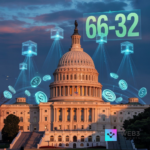If you’ve been paying even a little attention to the crypto world lately, you know stablecoins aren’t just some side project anymore. They’re becoming a big deal. And with the U.S. government finally taking steps to regulate them, one question is quickly moving to the center of the conversation:
Could stablecoins actually shake up the entire global financial system?
It sounds like a bold claim, but it’s not just hype. Stablecoins, especially the regulated kind, could completely change how people, companies, and even governments move money. Not someday. Not if everything goes right. We’re talking soon.
Let’s break it all down and look at what stablecoins are already doing, what’s changing, and where this is all heading.
Stablecoins: More Than Just Digital Dollars
Stablecoins were originally built as tools to make crypto trading easier. Unlike Bitcoin or Ethereum, which can swing wildly in price, stablecoins are pegged to something stable, usually the U.S. dollar. That means you can use them like digital cash without worrying they’ll lose half their value overnight.
But stablecoins have quickly outgrown their original purpose. Today, they’re being used to send money across borders, pay employees, settle trades, and even fund startups. Platforms like USDC and USDT move billions every day, and that number’s only growing.
The appeal? They’re fast, cheap, easy to use, and don’t require a bank account. For millions of people and businesses, especially in parts of the world where banking access is limited or outdated, stablecoins offer something better than the status quo.
What’s Broken in the Current Financial System
Let’s be honest: the global financial system is unstable.
International payments are slow, expensive, and buried under fees. It takes days to move money from one country to another, and banks eat a big chunk of it along the way. On top of that, billions of people still don’t have access to traditional banking at all.
Meanwhile, existing rails like SWIFT, wire transfers, and even credit cards are outdated. They weren’t built for the internet, let alone a world where anyone can send a video call or message across the globe in seconds.
Stablecoins solve that. They’re instant, borderless, and don’t rely on old-school banking infrastructure. That’s a massive unlock.
Why Governments Are Now Paying Attention
Until recently, stablecoins kind of flew under the radar. Regulators didn’t love them, but they didn’t really know how to deal with them either.
But things have changed. Now that stablecoins are being used in real-world payments and growing at insane speed, governments are stepping in to shape the rules.
The U.S. recently passed the Clarity for Payment Stablecoins Act (a.k.a. the GENIUS Act), signaling that America wants to lead, not lag. This move doesn’t just legitimize stablecoins in the U.S. It sets a tone for the rest of the world.
If regulated properly, stablecoins could become part of the mainstream financial system. That means banks might integrate them, businesses might adopt them at scale, and consumers might start using them without even realizing they’re “using crypto.”
The Global Impact: What Stablecoins Could Actually Change
Let’s talk about what this means in practice.
Imagine a small business in America paying a supplier in Brazil, instantly, without banks taking days and shaving off fees. Or a freelancer in Argentina getting paid in USDC within minutes instead of waiting on a wire transfer. Or a nonprofit delivering emergency aid in stablecoins that people can use immediately from a phone.
All of that is already starting to happen. But as regulations roll out and adoption increases, this kind of use could go from niche to normal.
Stablecoins also challenge the dominance of the dollar in a whole new way. Yes, many of them are still backed by USD. But they make that dollar more powerful, more flexible, more global, more programmable.
For countries facing inflation, economic instability, or capital controls, stablecoins are a lifeline. For developers and builders, they’re a building block. Wor consumers, they’re the easiest way to interact with digital finance.
The Risks That Can’t Be Ignored
Of course, no revolution comes without trade-offs.
Stablecoins aren’t perfect. If they’re not properly backed, they could collapse and hurt users. If regulation is too tight, they could lose the flexibility that makes them so powerful in the first place. And if too much power ends up in the hands of just a few issuers, we risk recreating the same problems crypto was supposed to fix.
There’s also geopolitical risk. If stablecoins become a key piece of global money movement, governments will want control. That could lead to regulation battles, fragmented standards, or outright bans in some places.
And then there’s privacy. If stablecoin data gets tracked and monetized by issuers, the line between innovation and surveillance gets blurry real fast.
Still, the Momentum Is Real
Despite the risks, the momentum behind stablecoins is undeniable.
Regulators are finally waking up. Developers are building around them. Big players like Visa, PayPal, and Stripe are already experimenting with them. And in parts of the world where financial systems are broken or simply too expensive, people are skipping traditional banks entirely and going straight to stablecoins.
Even central banks are starting to adapt. Some are looking at launching their own digital currencies (CBDCs), but many are also watching stablecoins closely and considering partnerships or integrations.
So, Can Stablecoins Really Reshape the Global Financial System?
Honestly? They already are.
No, we’re not replacing the dollar or the euro tomorrow. But stablecoins are changing how money moves. They’re making finance faster, cheaper, and more inclusive. And now that regulation is catching up, they’re getting the green light to go even further.
We’re witnessing the start of a shift. One where money moves more like the internet: fast, global, and always on.
So yes, stablecoins might be the quiet revolution that reshapes global finance. And the wild part? It’s only just beginning.








